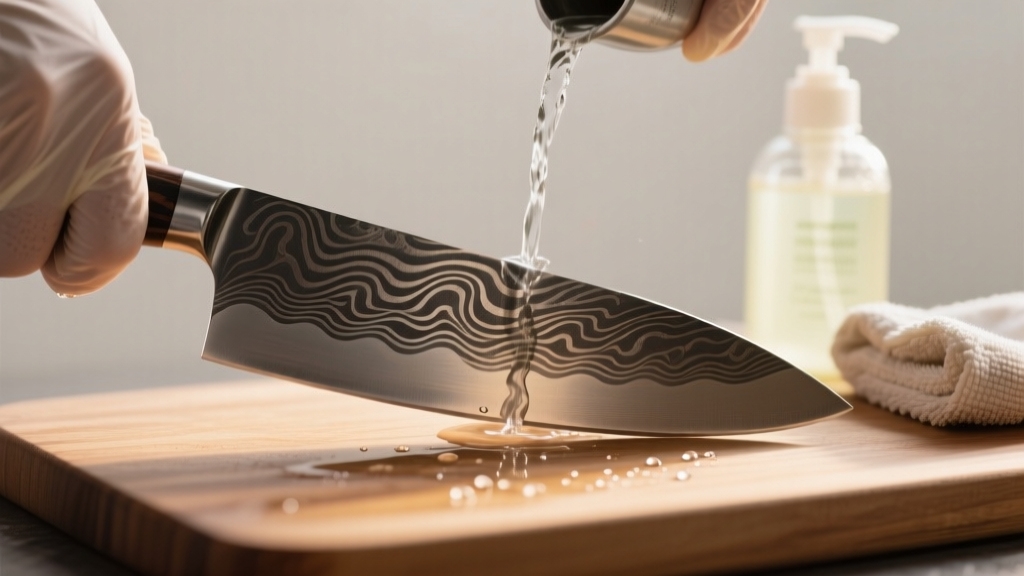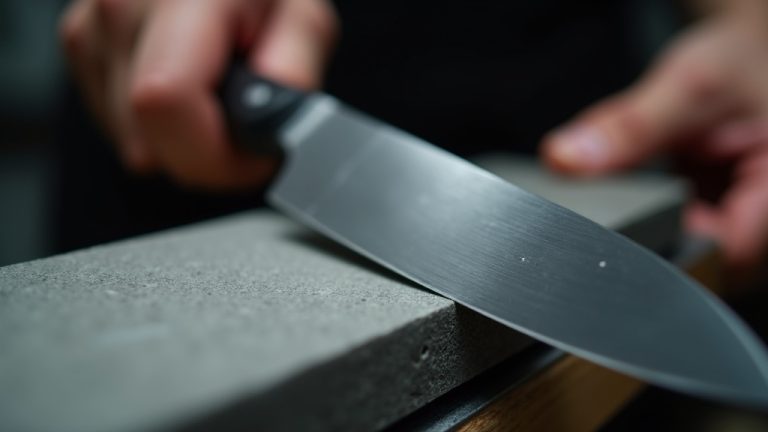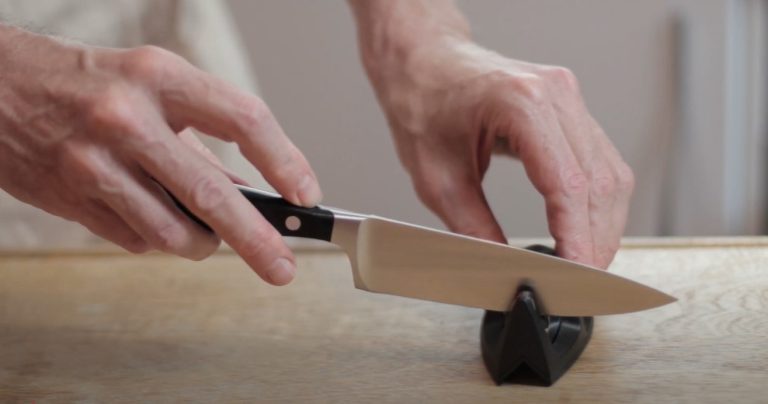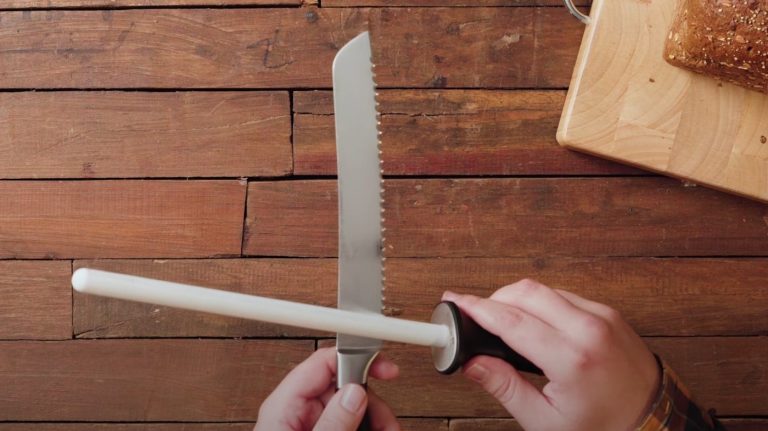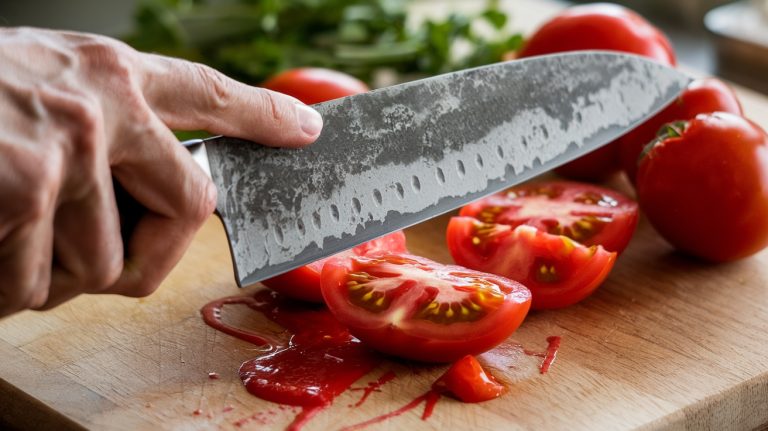How to Clean Damascus Steel Knives Safely?
To clean your Damascus steel knife, rinse it promptly under warm water and use mild soap with a soft cloth, following the blade’s pattern to avoid abrasion.
Avoid harsh chemicals and never soak the blade.
Dry immediately with a microfiber cloth to prevent rust, and apply a thin coat of food-safe mineral oil for protection.
Store the knife in a dry, ventilated space, avoiding damp environments.
Proper care preserves sharpness and aesthetics; understanding these details guarantees ideal maintenance.
Key Takeaways
- Rinse the knife immediately after use with warm water and mild dish soap, using a soft cloth or sponge to gently clean the blade.
- Avoid abrasive cleaners, harsh chemicals, or soaking, and use a soft-bristled toothbrush for intricate Damascus patterns.
- Thoroughly dry the knife with a microfiber or cotton cloth, especially in crevices, to prevent rust and moisture buildup.
- Apply a thin layer of food-safe mineral oil after drying to protect the blade and maintain its pattern and corrosion resistance.
- Store the knife in a dry, ventilated area away from humidity and avoid leather sheaths that trap moisture.
Essential Cleaning Supplies for Damascus Steel Knives
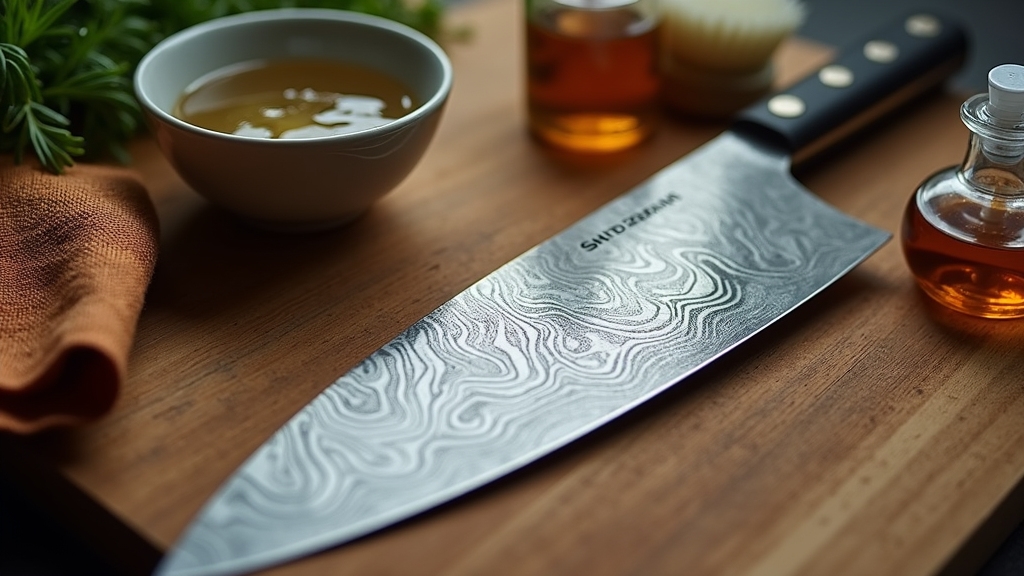
When cleaning Damascus steel knives, you should use warm, soapy water with a mild dish detergent to effectively remove dirt and food residues without compromising the blade’s delicate patina and etched patterns. Regular maintenance with a food-safe finish can enhance the blade’s longevity and appearance.
Avoid harsh chemicals, bleaches, or abrasive detergents that can strip the blade’s finish or cause corrosion.
Opt for soft, non-abrasive cloths like microfiber or cotton flannel to gently clean and dry the knife, preserving its intricate etching.
Keep separate cloths for washing and drying to prevent grit transfer, which may scratch the surface. It is important to dry immediately after washing with a soft cloth to prevent rust and preserve the blade quality.
For occasional deep cleaning, specialized knife soaps designed for delicate metalwork are ideal.
Step-by-Step Guide to Washing Your Damascus Blade
Hey there! So, let’s talk about how to take care of your Damascus blade. First things first, right after you’re done using it, go ahead and rinse it under some warm running water. This helps get rid of any loose debris before it has a chance to dry on the blade.
Once you’ve rinsed it off, grab a gentle sponge and add a little bit of mild soap. Just make sure to clean the surface carefully—no need to scrub hard! You want to avoid anything abrasive that might scratch or damage that beautiful pattern on your blade.
Using stainless steel wool and gun oil can also help remove surface rust without harming the Damascus finish. Remember, proper maintenance is key to preserving the blade’s durability and longevity.
After you’ve cleaned it up, the next step is super important: drying! Take a soft towel and dry the blade thoroughly. This helps prevent any moisture from hanging around, which could lead to rust.
Initial Rinse Technique
Although Damascus steel demands careful handling, you can effectively initiate the cleaning process by rinsing the blade under warm running water.
First, confirm the knife is securely held to prevent slips or accidents. Avoid using abrasive pads at this stage to protect the blade’s intricate pattern and prevent scratches or dullness. Using an ergonomic handle can enhance grip and reduce the risk of accidents during cleaning.
The warm water helps loosen and wash away residual food particles and surface debris without compromising the steel’s integrity.
Maintain a steady water flow and gently move the blade to allow thorough rinsing on all surfaces, paying particular attention to crevices where debris can accumulate.
This initial rinse sets the foundation for subsequent cleaning steps by reducing contaminants and preparing the blade for gentle soap application.
Gentle Soap Application
Following the initial rinse, applying a gentle soap solution effectively removes residual oils and particles without compromising the Damascus steel’s pattern or temper.
Use a mild dish soap diluted in lukewarm water to avoid harsh chemicals or concentrated residues that can damage the blade. This helps maintain the knife’s corrosion resistance and overall performance.
Employ a soft sponge or cloth to apply the solution, scrubbing gently along the Damascus pattern’s direction to prevent disruption of the etched layers. The blade’s unique wavy pattern is a result of multiple folded layers, so gentle cleaning preserves this distinctive feature.
Avoid circular or aggressive motions and abrasive tools like steel wool. For intricate areas, carefully use a soft-bristled toothbrush.
Wash the blade promptly after use, keeping it pointed away from your body for safety.
Rinse thoroughly with warm water to eliminate all soap traces, preventing spotting or tarnishing.
Avoid soaking to protect the blade’s temper and structural integrity.
Thorough Drying Method
When you finish washing your Damascus steel knife, promptly removing all moisture is critical to preserving its structural integrity and aesthetic. Use a clean, soft microfiber or cotton cloth to gently dab away water, especially around the handle and joints. Avoid abrasive materials or harsh rubbing. Proper maintenance requirements help extend the life of your blade and prevent damage.
After towel drying, air dry the blade in a low-humidity environment to evaporate residual moisture. This step is essential because high-carbon Damascus steel is prone to rust if moisture is left on the blade. Confirm the knife is fully dry before storage to prevent rust or tarnish. Applying a thin layer of food-safe mineral oil post-drying further protects the blade.
| Drying Step | Key Considerations |
|---|---|
| Initial Wipe | Use microfiber/cotton, dab gently |
| Air Drying | Low humidity, avoid enclosed spaces |
| Final Protection | Apply mineral oil to prevent rust |
Techniques for Preventing and Removing Rust
Since Damascus steel knives contain high carbon content, they require specific care to prevent rust formation. You must address moisture, acidity, and environmental exposure promptly. Here’s how you can effectively prevent and remove rust:
- Preventive Cleaning: Immediately wash the knife with warm water and mild soap after use. Avoid abrasive materials and dishwashers. Gently clean crevices to remove debris and moisture. Regular cleaning also helps maintain the knife’s distinctive wavy pattern. Using gentle cleaning methods similar to those recommended for other high-quality kitchen tools can prolong the blade’s life.
- Protective Coating: After thorough drying, apply a thin layer of food-safe mineral or specialized knife oil to form a moisture barrier. This helps maintain the blade’s aesthetic. Applying a protective coating is essential to prevent moisture-induced damage, much like the recommended practice for stainless steel kitchen utensils.
- Rust Removal: For minor rust, use a soft-bristled toothbrush with baking soda paste or fine 000 steel wool. Follow the Damascus pattern carefully. Rinse and dry completely to avoid recurrence. Employing gentle abrasive techniques ensures the blade remains sharp and preserves its integrity, similar to maintaining ultra-sharp blades on vegetable peelers.
Proper Drying and Storage Methods
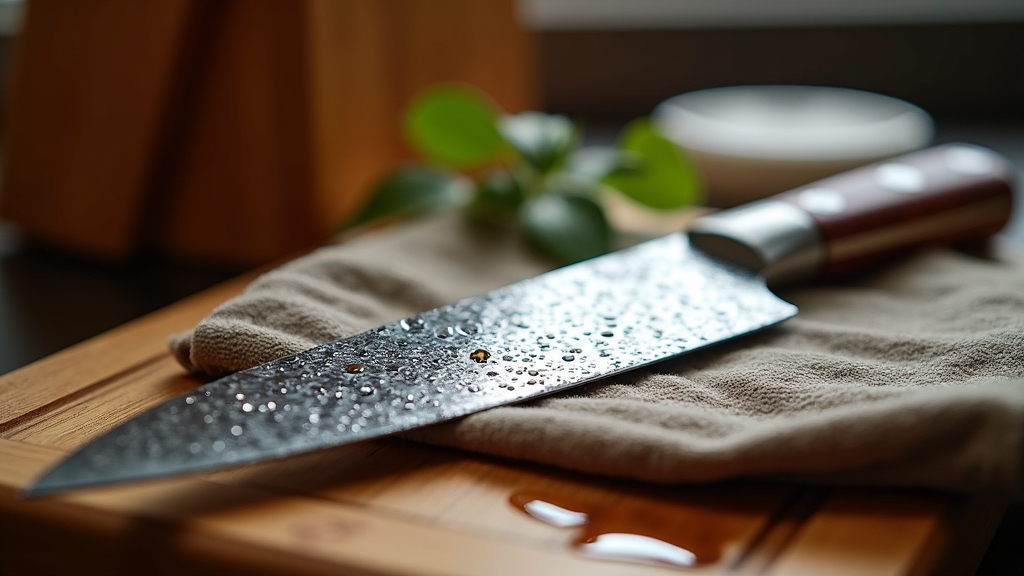
Although thorough cleaning is essential, proper drying and storage play an equally vital role in preserving your Damascus steel knife’s integrity.
Immediately after washing, wipe the blade and handle with a soft, clean cloth to remove all moisture, paying close attention to crevices. Allowing brief air drying to eliminate residual dampness is indispensable for high-carbon Damascus steel and helps maintain blade stability.
Wipe blade and handle promptly with a soft cloth, ensuring moisture is removed from all crevices.
Avoid abrasive cloths that could scratch the blade’s pattern.
Store the knife in dry, well-ventilated areas away from humidity. It is important to store in a dry place to prevent rust formation. Using storage solutions with corrosion-inhibiting properties can further protect your knife.
Avoid leather sheaths and damp drawers to prevent corrosion.
Apply a thin coat of food-grade mineral oil or specialized knife oil after drying to create a moisture barrier.
Use storage solutions with corrosion-inhibiting properties and keep knives away from extreme temperature fluctuations to maintain blade stability and prevent condensation.
Recommended Handling and Cleaning Frequency
Hey there! When it comes to taking care of your Damascus steel knife, it’s super important to clean it right after you use it. This is especially true if you’ve been chopping up acidic or raw foods. You definitely want to avoid any corrosion or nasty residue buildup.
Proper storage, such as using a knife block or drawer organizer, also helps maintain the knife’s condition. Similar to how brisket requires specific care depending on its cut and use, understanding the material and treatment of your knife ensures longevity and performance.
Now, let’s talk about sharpening. You don’t need to sharpen your blade all the time—only do it when you really notice that it’s not cutting as well as it used to.
In the meantime, regular honing is your best friend. It keeps the edge aligned without taking away too much material, much like maintaining the ideal cooking temperature is essential for tender brisket cuts.
Cleaning Timing Tips
When handling Damascus steel knives, cleaning them immediately after each use prevents food residue from drying and staining the blade. This is crucial as it can compromise its integrity. Avoid soaking the knife to reduce rust risk.
Use warm, mild soapy water with a soft cloth or sponge, rinse thoroughly, and dry completely to prevent moisture-induced corrosion.
Quick wipe-down of Damascus steel knives (like Aurora and Knox) with a dry cloth to preserve patterns is also recommended. Using a sharpener with a magnetic angle guide can help maintain the blade’s edge during regular maintenance.
Follow these timing tips to optimize blade longevity:
- Clean and dry your knife immediately after every use to maintain blade condition and prevent corrosion.
- If the knife is used infrequently, clean promptly after handling, then apply a protective oil or wax before storage.
- Store the knife only after thorough drying and oiling, in a dry, ventilated environment to prevent oxidation. Proper storage prolongs knife life and maintains both its aesthetic and functional qualities.
Sharpening and Honing
Proper cleaning routines lay the foundation for effective sharpening and honing of Damascus steel knives.
Begin sharpening only when honing no longer restores edge performance, typically after several weeks to months depending on use. The layered structure of Damascus steel requires careful maintenance to preserve both its functionality and distinctive appearance.
Additionally, maintaining a balance between edge hardness and spine toughness, similar to the 65 HRC edge and softer spine in Steelport knives, can enhance blade durability.
Maintain a consistent 15–20° sharpening angle using water-soaked whetstones: 1000–3000 grit for sharpening and 5000+ grit for polishing.
Avoid pull-through sharpeners to prevent blade damage; instead, use manual sharpeners with angle guides or leather strops for burr removal and edge refinement.
Hone regularly with a steel or leather strop to realign microscopic edge irregularities, prolonging sharpness and reducing metal removal.
Apply light, even pressure during honing to protect blade temper.
Always secure stones and use minimal pressure to avoid chipping or overheating.
This disciplined approach preserves the blade’s integrity, pattern, and cutting efficiency.
Tips for Polishing and Enhancing Aesthetic Appeal
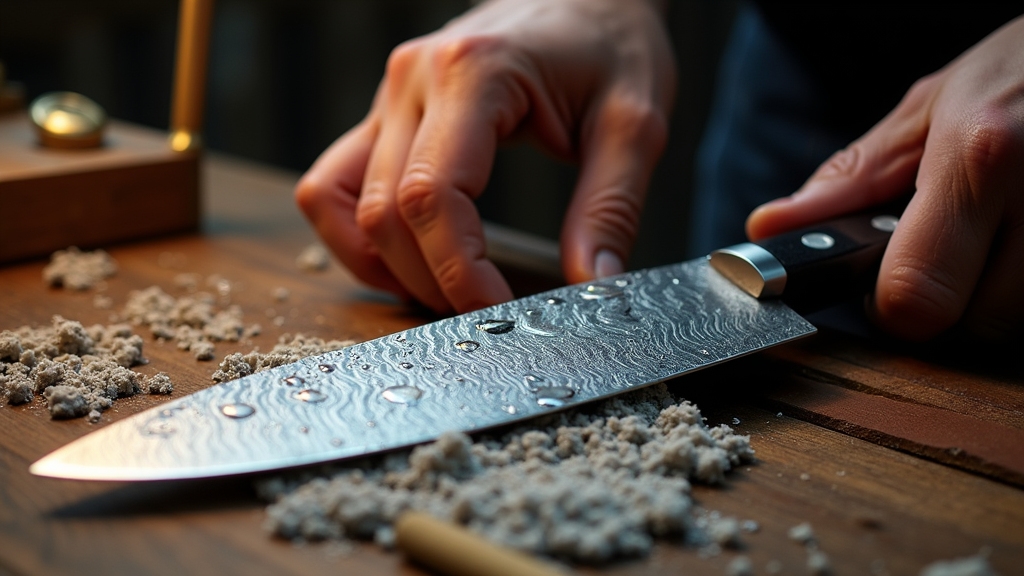
Although polishing Damascus steel knives demands patience and attention to detail, mastering the process considerably enhances the blade’s visual appeal and longevity.
Start by cleaning the blade thoroughly to remove oils and residues, ensuring a uniform surface for polishing. It is crucial to avoid harsh chemicals like bleach or ammonia during cleaning to protect the intricate patterns from damage.
Use progressively finer abrasives—from 600 to 3000 grit—to achieve a smooth, mirror-like finish without scratching or heat damage.
Finally, apply protective oils to preserve the polish and deepen the Damascus pattern’s contrast.
- Employ gentle, consistent pressure with fine grit sandpapers or leather strops to avoid uneven surfaces.
- Use mild acid etching selectively to accentuate the layered pattern, neutralizing promptly to prevent damage.
- Finish with a thin coat of mineral or food-safe oil to maintain shine and prevent oxidation.
Best Practices for Maintaining Blade Sharpness
Enhancing the visual appeal of your Damascus steel knife goes hand in hand with maintaining its sharpness, as a well-kept edge optimizes both performance and longevity.
Start by rinsing the blade under warm water and cleaning it with mild soap using a soft sponge. Avoid soaking and abrasive materials to prevent rust and edge damage. Applying a thin layer of Renaissance Wax after drying helps prevent moisture contact and rust formation.
Dry the blade immediately and neutralize acidic residues with a baking soda solution.
Store the knife in a dry environment, preferably in a sheath with corrosion-inhibiting lining, to protect the edge from nicks.
Regularly apply food-safe mineral oil to create a moisture barrier.
Hone frequently to realign the edge, and sharpen with quality whetstones every 1–2 months.
Use the knife appropriately, avoiding hard or frozen materials to prevent chipping and prolong edge integrity.
Frequently Asked Questions
Can Damascus Steel Knives Be Safely Used With Acidic Foods?
You can use Damascus steel knives with acidic foods, but you need to be cautious.
Acidic ingredients like citrus or tomatoes can cause surface etching and accelerate corrosion, especially on high-carbon Damascus steel.
To minimize damage, rinse and dry the blade promptly after use and avoid prolonged contact with acids.
Opting for Damascus knives with a stainless steel core improves acid resistance, but regular inspection and maintenance remain essential for safe, durable use.
Is It Safe to Use Vinegar for Cleaning Damascus Steel Blades?
Think of vinegar as a double-edged sword for your Damascus blade. Yes, you can use vinegar safely to dissolve surface rust, but only for brief periods.
Too long, and it’ll etch away the blade’s beauty. Soak your knife just enough to loosen rust, then rinse and dry thoroughly to halt acid’s bite.
Avoid prolonged exposure and always follow up with oiling to shield the steel’s intricate patterns and preserve its integrity.
How Do Temperature Changes Affect Damascus Steel Knives?
Temperature changes critically impact Damascus steel knives by altering hardness, toughness, and structural integrity.
Rapid cooling increases hardness but risks brittleness, while slow cooling reduces hardness and edge retention.
Repeated thermal cycling can stabilize the microstructure, but overheating causes decarburization, grain coarsening, and pattern fading.
Precise heat control during forging, tempering, and cooling guarantees ideal performance and appearance.
Avoid exposing your knife to extreme or fluctuating temperatures to maintain its quality.
Are Damascus Steel Knives Dishwasher Safe?
You shouldn’t put Damascus steel knives in the dishwasher. Over 70% of users report accelerated rust and blade damage from this practice.
The layered metals form an electrochemical cell in dishwasher detergents, causing rapid corrosion. High-temperature water and aggressive salts worsen this effect, compromising blade integrity.
Instead, hand wash immediately with mild detergent, dry thoroughly, and oil the blade to maintain its layered structure and prevent oxidation.
This ensures long-term performance and aesthetics.
Can You Sharpen Damascus Steel Knives at Home Without Damage?
Yes, you can sharpen Damascus steel knives at home without damage if you use proper tools and techniques.
Use natural whetstones with 1000-3000 grit for sharpening and maintain a consistent 15-20 degree angle.
Avoid electric or pull-through sharpeners to prevent heat buildup and temper loss.
Hone regularly with a steel or leather strop to minimize sharpening frequency, preserving the blade’s structure and distinctive Damascus pattern.
Keep Your Damascus Steel Knives Looking Timeless
Caring for your Damascus steel knife is like tending a delicate masterpiece. Precision and consistency are your brushes.
By cleaning with the right supplies, drying thoroughly, and storing properly, you shield your blade from rust’s relentless siege. Regular maintenance sharpens not just the edge but the knife’s legacy.
Embrace these practices diligently, and your Damascus steel will remain a gleaming sentinel of craftsmanship. It will be ready to perform with unwavering excellence every time you draw it.

